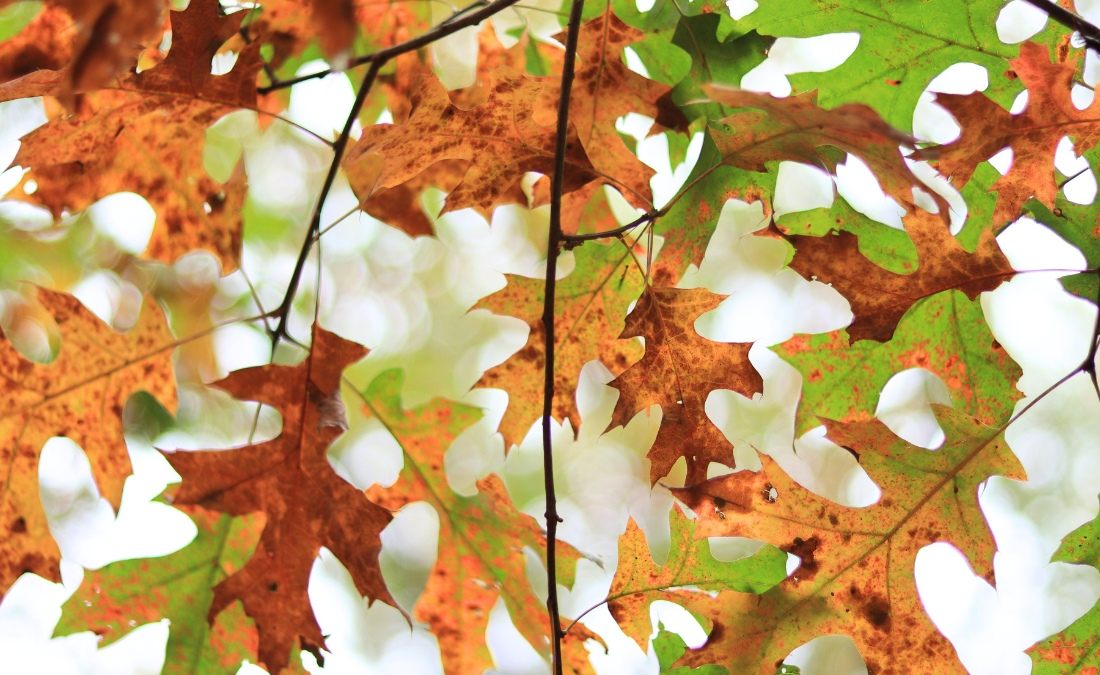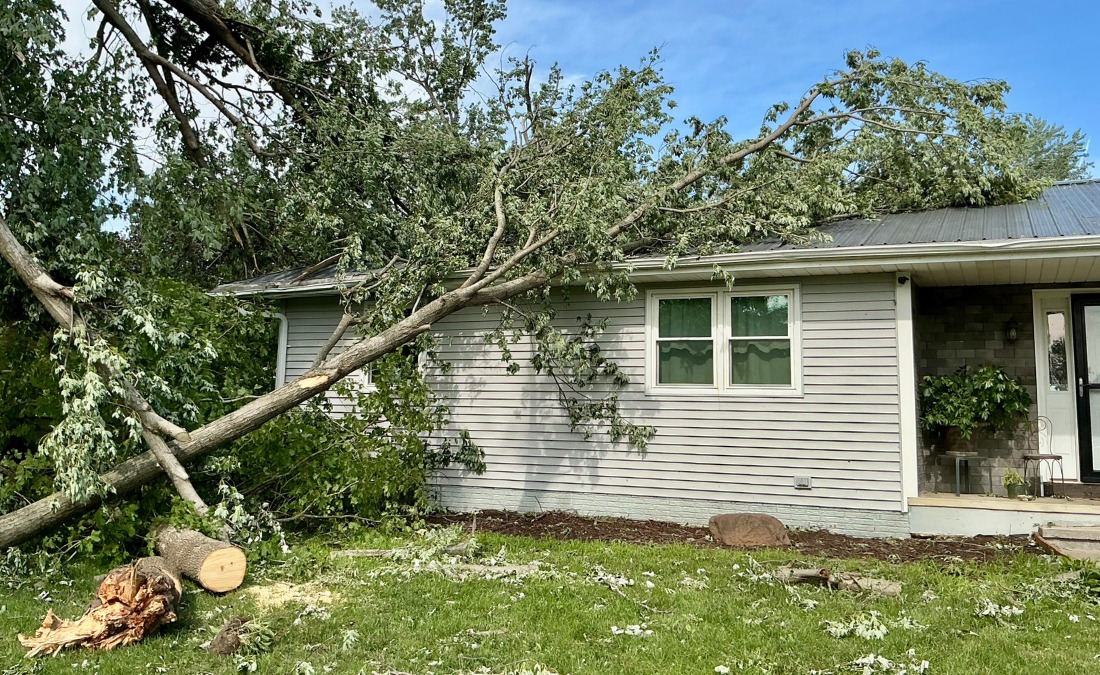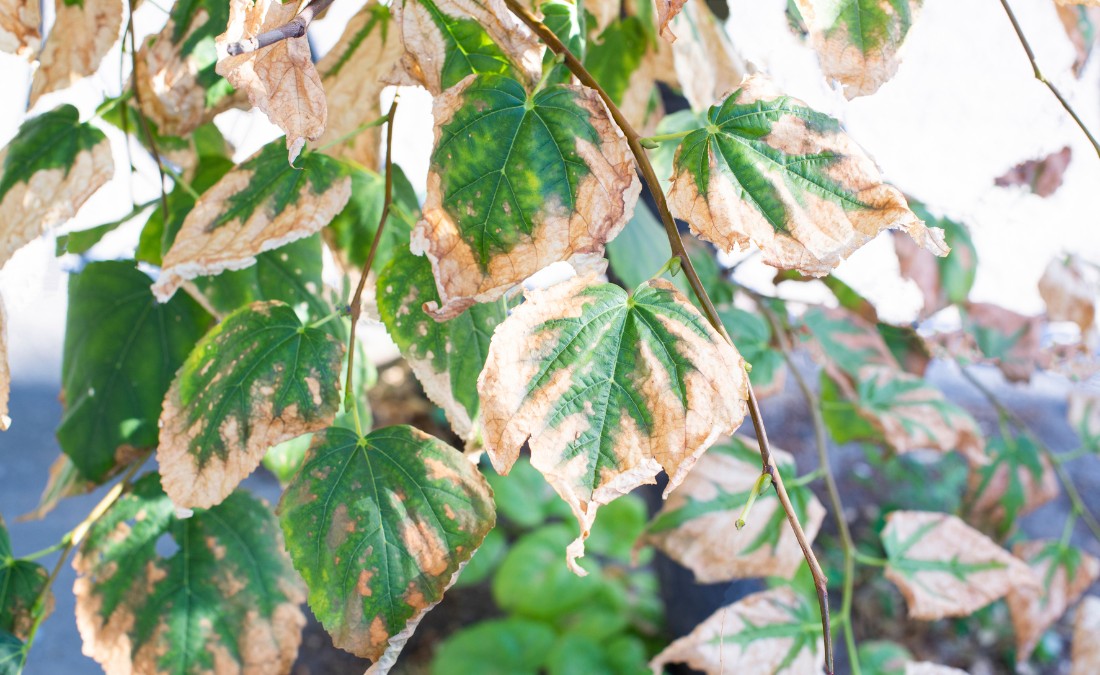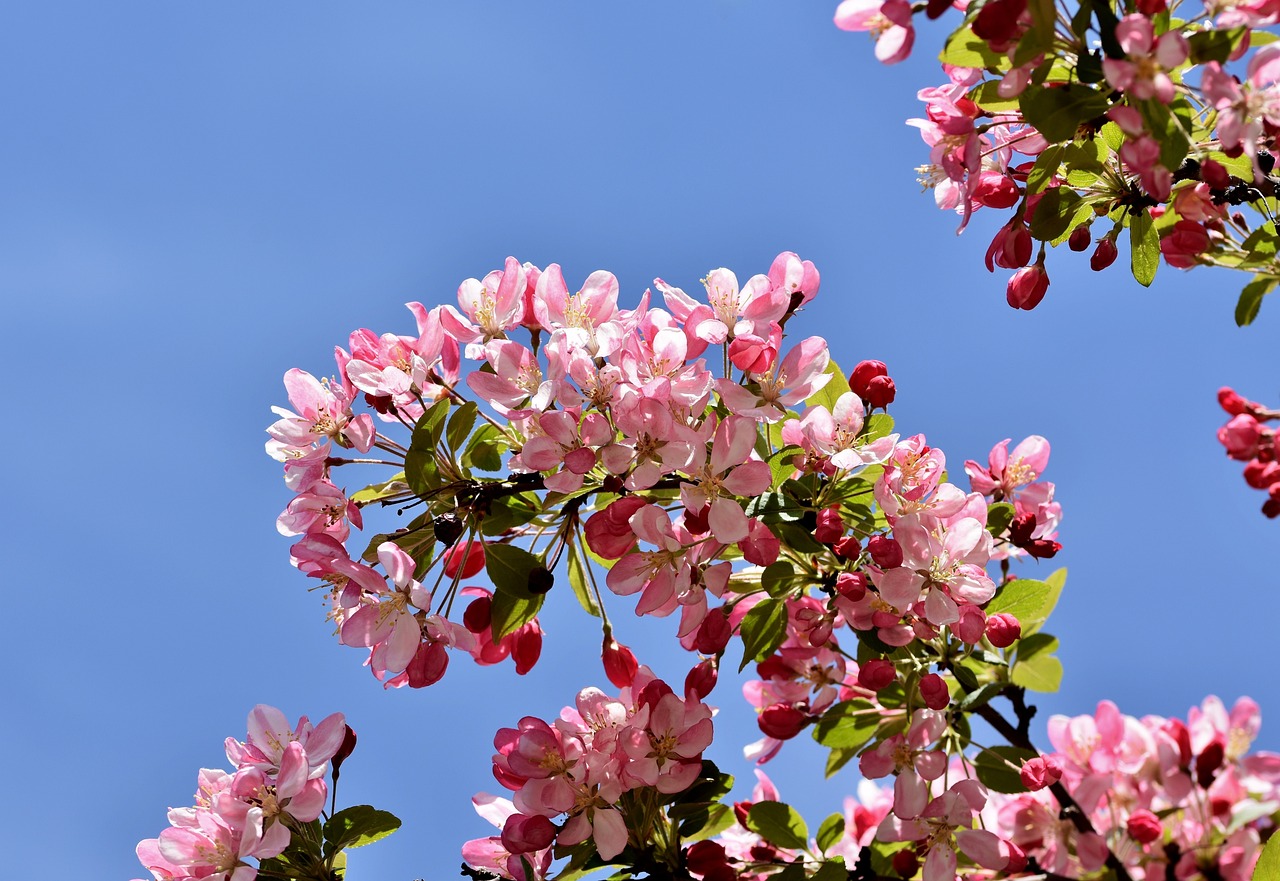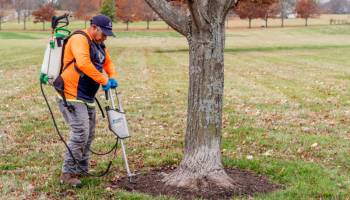Signs of Drought Stress in Mature Trees: What Davenport Homeowners Need to Know
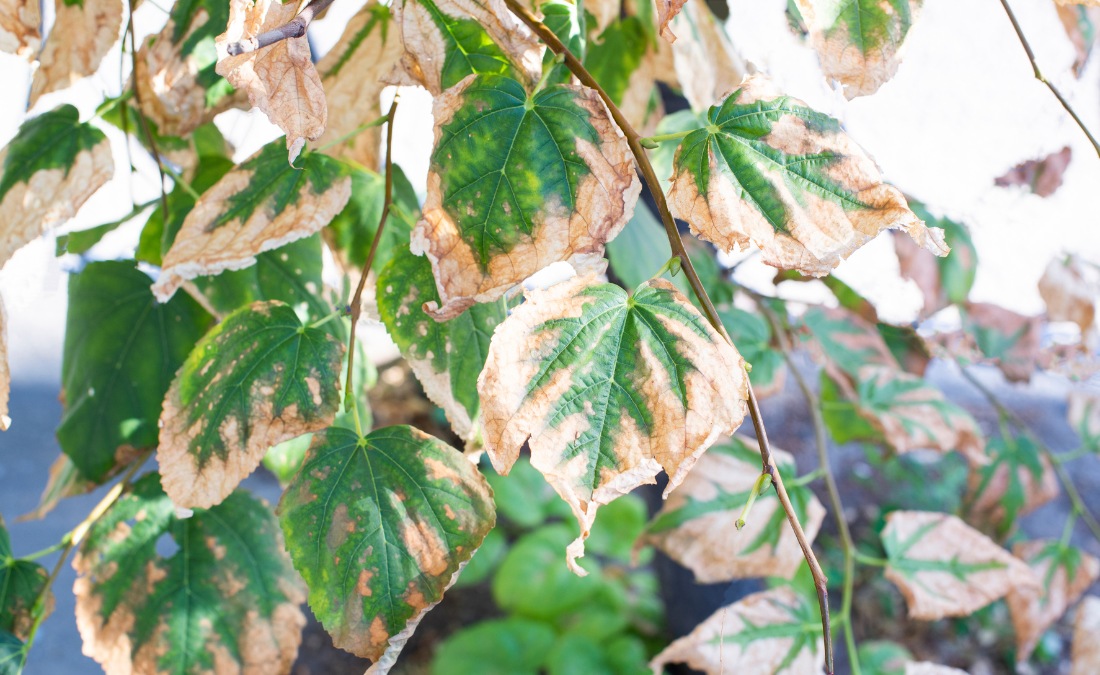
Your trees could be silently dying despite recent flooding. Discover 7 drought stress signs in mature trees and why fall treatment saves them.
Don’t let last month’s Quad Cities flooding fool you – your mature trees could be dying from thirst. In Iowa, it’s not unusual to go from soaking rains to weeks of dry weather. These “weather whiplashes” can dry out soil quickly, even during months that are normally wetter, leaving trees short on water when they need it most.
For those living in the Quad Cities area, spotting drought stress early is essential to protecting valuable trees. The signs you see this summer often mean fall treatment is needed for the best recovery. With the right timing and professional care, even severely stressed mature trees can bounce back and continue adding beauty and value to your property for decades to come.
Key Takeaways
- Wilting, leaf discoloration, and canopy thinning are warning signs that require immediate assessment before permanent damage occurs in mature trees.
- Yellow leaves with green veins indicate nutrient problems worsened by drought conditions in Quad Cities’ alkaline soils and often mimic simple drought stress.
- The best time to treat drought-related damage is during dormancy (in the fall) when trees can absorb nutrients most effectively, meaning summer symptoms need fall treatment.
- ISA Certified Arborists can distinguish between drought stress, disease, and other problems requiring different treatments, preventing costly mistakes.
- Eastern Iowa’s heavy clay soil retains water poorly and becomes compacted, making mature trees more vulnerable to drought stress than in other regions.
- Proactive care for established trees prevents the significant cost of removing and replacing mature specimens, protecting your landscape investment.
What Does Drought Stress Look Like in Mature Trees? 7 Warning Signs to Watch for
The earliest signs of drought stress in mature trees often go unnoticed until the damage becomes severe. Unlike younger trees that show distress quickly, established trees can mask their struggle for months or even years before visible symptoms appear.
Here are the seven warning signs every Quad Cities homeowner should watch for:
- Temporary Afternoon Wilting: Leaves looking limp and droopy during the hottest part of the day (especially 2-5 PM) but perk up by evening or early morning, indicating your tree is losing water faster than its roots can replace it.
- Leaf Color Changes: Healthy deep green foliage starts looking dull or pale, progressing to yellow-green before browning begins at the edges, creating a burned appearance particularly noticeable on maples and oaks common to Davenport and Bettendorf properties.
- Premature Leaf Drop: Trees start shedding green or slightly yellowed leaves in July and August as they cut their losses to conserve water and energy for survival.
- Canopy Thinning: You’ll start seeing more sky through branches that were previously full, with the overall crown appearing sparse compared to previous years.
- Smaller Leaf Size: New growth emerges significantly smaller than normal, showing your tree is struggling to support full-sized foliage.
- Early Fall Color: Trees start changing color in late August or early September in our Iowa climate, which is actually a distress signal rather than seasonal beauty.
- Increased Seed or Fruit Production: Stressed trees often produce abundant seeds or fruit as they attempt to reproduce before potentially dying.
EXPERT INSIGHT: “One of the most common mistakes we see in the Quad Cities is assuming that surface moisture means a tree is well-watered. In our clay soils, water can pool near the top while the deeper layers – where the fine feeder roots actually absorb moisture – stay dry. That’s especially risky for mature oaks and maples. Their wide, deep root systems rely on consistent moisture throughout the entire root zone, and when that clay dries out below the surface, it stresses the tree long before the leaves show obvious signs. – Brian Ewers, PHC Tech and ISA Certified Arborist at Advantage
When Drought Stress Becomes Dangerous: Critical Signs Your Trees Need Professional Help
Some drought stress symptoms move beyond cosmetic concerns and signal immediate safety hazards that require professional intervention. The effects are not always immediate and the full extent of the damage to trees can take one to two years to become apparent, which makes early professional assessment crucial.
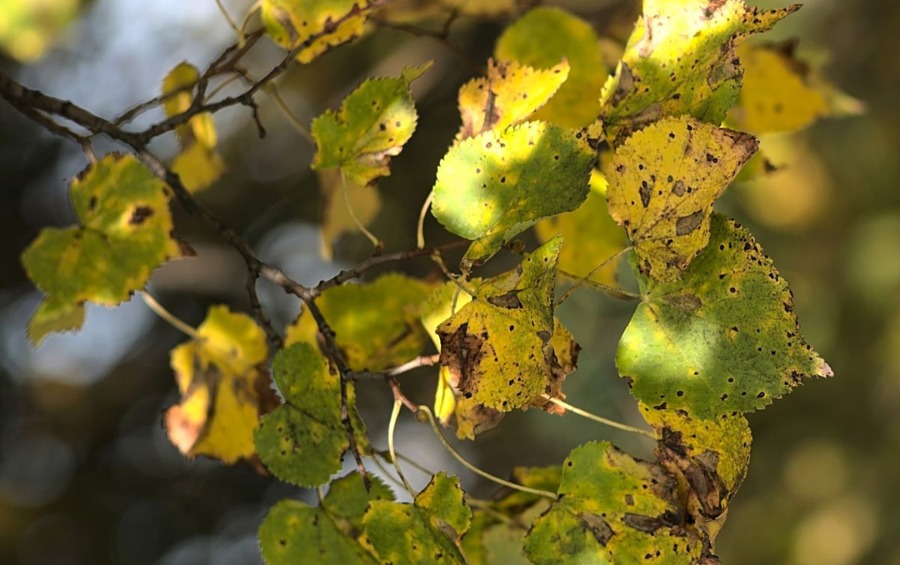
Advanced drought stress symptoms like severe leaf scorch require immediate professional intervention to save the tree.
Structural Warning Signs of Drought Stress in Mature Trees
- Branch Dieback: Starting from the top and working down, indicates severe stress that can quickly progress to whole-tree failure.
- Bark Cracking and Splitting: Occurs when internal water pressure fluctuates dramatically, creating entry points for insects and diseases.
- Structural Instability: Root systems die back from prolonged water stress, taking days to weeks to regrow the root hairs necessary to absorb rainfall.
Signs of Secondary Pest and Disease Problems
Drought-weakened trees become magnets for opportunistic pests and diseases that healthy trees would normally resist. Watch for these warning signs that indicate your stressed tree is under attack:
- Sawdust-Like Boring Dust: Small piles of wood shavings around the base indicate wood-boring beetle activity.
- Exit Holes in Bark: Round or D-shaped holes show where adult borers have emerged after feeding inside the tree.
- Fungal Growth: Mushrooms, conks, or other fungal structures on the trunk signal internal decay.
- Oozing or Cankers: Dark, sunken areas on bark or sticky sap discharge indicates bacterial or fungal infection.
- Unusual Insect Activity: Large numbers of ants, beetles, or other insects congregating on the tree.
Understanding Hidden Damage in Mature Trees
The most dangerous aspect of drought stress in mature trees is that visible symptoms often lag far behind the actual damage occurring within the tree. Large, established trees have extensive root systems and stored energy reserves that can mask serious problems for months or years. When these reserves are finally depleted, the tree experiences what appears to be sudden failure, but the decline actually began seasons earlier.
This delayed response happens because trees prioritize survival by shutting down non-essential functions first, maintaining the appearance of health while their root systems progressively die back. By the time visible symptoms appear in the canopy, significant root damage may have already occurred, making recovery more difficult and expensive.
What Drought Stress Is Often Mistaken For
Many homeowners misdiagnose drought stress because its symptoms can look remarkably similar to other tree problems. Understanding these look-alikes helps you avoid wasting time and money on the wrong treatments while your trees continue to decline.
Common Misdiagnoses
- Iron Chlorosis: Creates bright yellow leaves with dark green veins, worsened by Iowa’s alkaline clay soils where iron becomes unavailable to trees.
- Heat Stress: Causes leaf scorch like drought stress, but it typically affects the entire canopy uniformly and resolves when temperatures cool.
- Sun Scald: Brown, crispy leaf edges similar to drought stress, but usually limited to south or west-facing sides of trees.
- Overwatering Damage: Surprisingly causes yellowing leaves that mimic drought stress, but leaves turn yellow uniformly and may be accompanied by fungal growth or sour soil smell.
- Fungal Diseases: Conditions like Verticillium wilt cause sudden branch dieback that looks like severe drought stress, but typically affect specific branches rather than the entire tree.
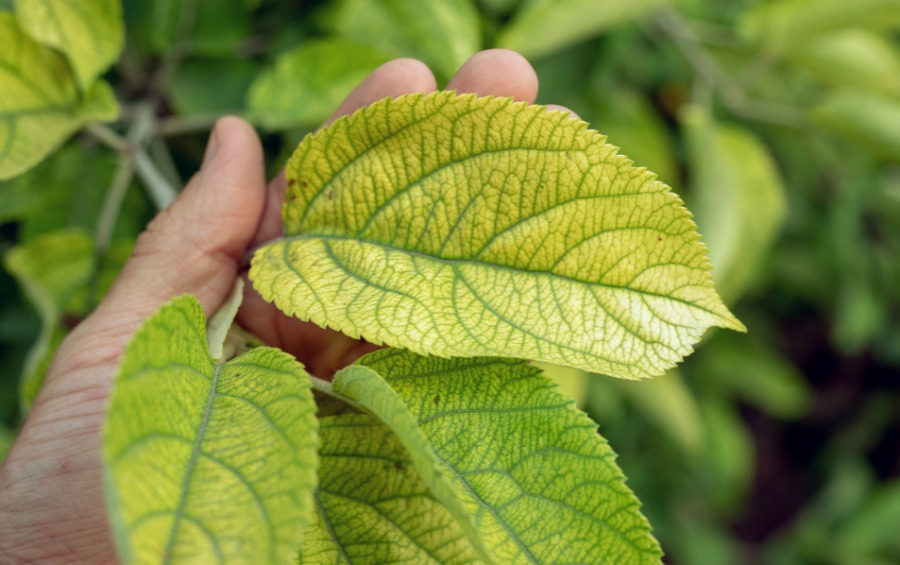
Iron chlorosis creates distinctive yellow leaves with green veins – often confused with drought stress but requiring different treatment.
Why Professional Diagnosis Matters
Each of these conditions requires completely different treatment approaches. Iron chlorosis needs specialized nutrient applications, fungal diseases require targeted treatments, and true drought stress needs improved irrigation and soil management. Misdiagnosis can waste hundreds of dollars while your valuable trees continue declining, making prompt professional intervention critical.
A Certified Arborist can correctly identify the underlying problem and get your tree started on a recovery plan suited to their needs.
How Certified Arborists Protect Mature Trees from Stress After Drought in Iowa’s Clay Soil
Professional tree care becomes essential when dealing with the unique challenges of eastern Iowa’s heavy clay soils and variable precipitation patterns. The expertise of ISA Certified Arborists makes the difference between temporary fixes and long-term tree health solutions.
Unlike general landscapers or tree removal companies, Certified Arborists approach drought stress with a comprehensive understanding of how soil chemistry, tree biology, and local climate conditions interact. This scientific approach ensures treatments address root causes rather than just visible symptoms.
Professional Assessment Process
- Soil Analysis and pH Testing: The foundation of effective treatment to determine specific challenges affecting your property.
- Species-Specific Evaluation: Understanding how different trees respond to local soil and climate conditions.
- Risk Assessment: Identifying safety hazards before they become dangerous.
Advanced Treatment Methods
Professional treatment options include:
- Deep Root Fertilization: Delivers nutrients directly to the root zone.
- Trunk Injection Systems: Provides immediate nutrient availability for severely stressed trees.
- Soil Amendments: Improves soil structure and pH for long-term health.
- Iron Chelate Applications: Addresses iron chlorosis in alkaline soils.
Integrated Tree Health Management
Professional arborists understand that drought stress, soil compaction, nutrient deficiencies, and pest pressures all interact in ways that require comprehensive treatment strategies rather than single-solution approaches. Trees in areas with high pH levels struggle to absorb important nutrients such as iron and magnesium, which makes ongoing professional care valuable for protecting mature tree investments.
Why Fall Tree Treatment Works Best for Summer Drought Damage (And When to Start)
The timing of tree treatments might seem counterintuitive, but there’s solid science behind why fall applications work best for problems you notice during summer heat. Understanding this timing can mean the difference between saving a valuable mature tree and losing it entirely.
Here’s why fall treatment is more effective for mature trees suffering from drought stress:
- Root Activity During Dormancy: Root systems remain active in absorbing nutrients and water during mild fall and winter periods in Iowa.
- Nutrient Storage Timing: Trees use stored energy from fall treatments to produce healthy new growth when spring arrives.
- Treatment Absorption Rates: Recovery can be very rapid with fall applications, often showing noticeable greening within weeks.
- Reduced Competition: Fall treatments allow trees to process nutrients without the stress of active photosynthesis and rapid growth.
The treatment window for our area runs from late September through November, before ground freeze but after leaves begin dropping. Spring treatments compete with the tree’s natural energy demands for new leaf production and early growth, making them less effective than fall applications that work with the tree’s natural cycle.
Frequently Asked Questions About Drought Stress in Mature Trees
Can mature trees recover from severe drought stress?
Yes, but recovery depends on early intervention and professional treatment and takes time; sometimes even weeks or months. Wait until next spring to make a final determination. You may be pleasantly surprised to find your beloved tree has regrown roots and regained its strength during fall and winter.
What’s the difference between drought stress and disease symptoms?
Drought stress typically shows gradual yellowing from leaf edges inward, while diseases often create distinct patterns like spots, blotches, or sudden wilting of entire branches. However, professional diagnosis is crucial because drought stress and iron chlorosis symptoms can mimic other nutrient deficiencies.
What should I do if I notice these drought stress signs?
First, check soil moisture by digging 6-8 inches deep near the tree’s drip line. If the soil is dry, begin deep watering immediately. However, if you notice multiple symptoms like yellowing leaves with green veins, bark cracking, or branch dieback, contact a Certified Arborist right away. Early professional intervention can save trees that might otherwise be lost to prolonged stress damage.
How do I distinguish drought stress from other tree problems?
Professional diagnosis is crucial because iron chlorosis symptoms can mimic the same symptoms as nitrogen deficiency and other problems. Our Certified Arborists use soil testing, visual assessment, and knowledge of local conditions to accurately identify the root cause of tree stress symptoms.
How often should mature trees be watered during dry periods?
Mature trees need about one inch of rainfall per week and benefit from deep, infrequent watering rather than frequent shallow applications. Professional maintenance programs can help determine the specific watering needs based on your soil type, tree species, and local weather conditions.
Are some tree species more drought-tolerant than others in Iowa?
Yes, native species like bur oak, hackberry, and Kentucky coffee tree typically handle drought better than non-natives like pin oak or river birch. However, even drought-tolerant species can struggle in our heavy clay soils during extended dry periods. Proper species selection and soil management make the biggest difference in long-term tree health.
How can I prevent drought stress in valuable mature trees?
Protecting mature trees from drought stress starts with proactive care. Here are key steps to keep them healthy and resilient year-round:
- Mulch Properly: Apply organic mulch around the base to retain soil moisture and regulate temperature.
- Protect Root Zones: Prevent soil compaction by keeping heavy equipment, vehicles, and foot traffic away from roots.
- Use Drip Irrigation: Install a drip irrigation system to provide consistent, deep watering during dry periods.
- Schedule Annual Assessments: Have a certified arborist inspect trees yearly to detect and address problems before they become costly.
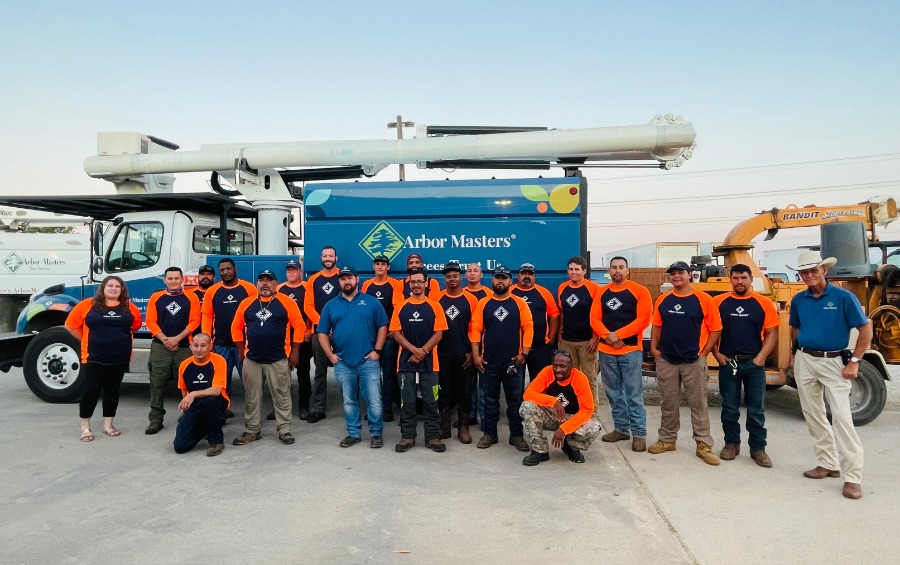
Don’t Wait: Advantage Can Save Your Mature Trees from Drought Stress
Don’t wait for drought stress symptoms to worsen into permanent damage or safety hazards. Your mature trees represent decades of growth and thousands of dollars in landscape value that deserve professional protection.
At Advantage, our ISA Certified Arborists and TCIA-accredited team has been serving Davenport, Bettendorf, Moline, LeClaire, and the entire Quad Cities area since 1960. We understand the unique challenges that Iowa’s clay soils and variable climate present to your valuable mature trees. From early detection of drought stress to specialized fall treatments for iron chlorosis, we provide the expert care your trees need to thrive.
Remember: “Trees Trust Us” isn’t just our tagline – it’s our promise to provide the professional expertise your mature trees deserve. Call 563-355-7508 today or request your professional tree assessment to protect your landscape investment before drought stress becomes irreversible damage.

Get the latest local news, tree care tips, special offers, and company updates directly to your inbox! It's easy to subscribe and there's no spam - we promise.
"*" indicates required fields

